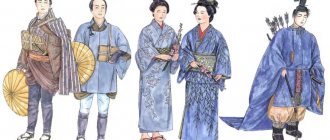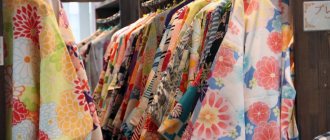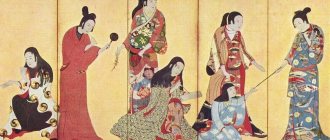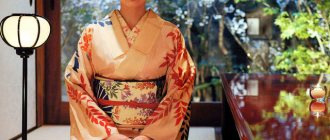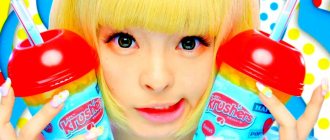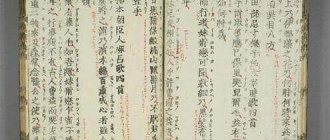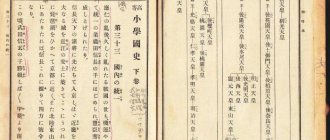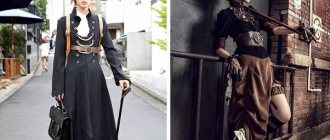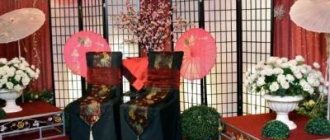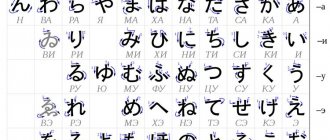The national Japanese costume for beautiful ladies has long gone beyond the borders of its native country and won the hearts of fashionistas around the world. Young ladies from America and Europe fell in love with women's kimonos for their simplicity of cut, incredible beauty and maximum comfort while wearing.
Japanese kimono
Women's Japanese kimono is distinguished by an indescribable, incomparable color, subtle elegance of style, bright individuality of shapes and colors. The first mentions of this outfit can be found in ancient manuscripts dating back to approximately the 7th century AD. At that time, a traditional kimono model appeared, which in appearance resembled a swinging robe with long sleeves.
Subsequently, stylists created many variations based on the classic version, decorated it with additional decorative elements, increased the length and made the cut wider. Women's products were designed to demonstrate the beauty and grace of their owner, attract interested glances and increase her level of confidence in her own seductiveness and attractiveness.
For this reason, to create women's kimonos, only high-quality fabrics in bright colors have been used in the past and today. The main color accent is always placed on the obi belt. Fresh pink, light green, lilac, purple, and blue shades are often used. The use of floral and plant prints is widespread; seasonal motifs are popular - momiji maple leaves in autumn, sakura, peach or plum flowers in spring, thin matzo pine needles in winter.
Since ancient times, real women's kimonos have been made exclusively by hand, and this applies not only to cutting, joining and sewing parts, but also to painting and artistic design of fabrics. All necessary rules and secrets are inherited from the master to the successor. Meanwhile, today only expensive suits are made directly in Japan using this technology, and women's kimono-style dresses and other clothing are produced by many manufacturers using a standard system.
Types of kimono
In addition to the already mentioned types of traditional attire, there are others.
Children's everyday kimono is called hanten. Female species include:
- Yukatu is casual clothing, which is a light cotton robe. It is worn in the warm season and at home, most often sewn from pastel-colored fabrics with floral motifs.
- Iromuji, which is also an everyday garment worn for certain ceremonies, arts, or certain crafts.
- Komon is another type of casual clothing that is distinguished by its richness of decoration.
- Tsukesagi - plain clothes for going out.
- Kurotomesode is black clothing with expensive trim, intended for married women who attend important events.
Men's kimonos are not so diverse:
- sama – casual clothing worn for physical work; it is made of black or gray fabric;
- Jinbei is an analogue of yukata; in addition to a cotton jacket, shorts are also worn;
- tanzen - outerwear, a Japanese version of a coat;
- happ, which is a universal jacket with narrow sleeves, which is sewn from cotton.
It is a mistake to call kimono clothing for traditional martial arts. In fact, such clothing in a broad sense is called dogi, and the name options depend on one or another type of martial arts: karategi for karate, judogi for judo, etc.
Women's clothing in kimono style
The Japanese kimono for women is currently used to create many styles of dresses, robes, shirts and even coats. Such products are very different from the clothes that young ladies are accustomed to in Europe, America and other parts of the world, with the exception of the East. Meanwhile, since fashion does not stand still, modern variations can only vaguely resemble a traditional Japanese costume, in terms of its characteristic features.
Kimono dress
Charming women's kimono dresses are very bright, beautiful and comfortable dresses that are suitable for young ladies with any type of figure. So, these products can be safely worn by both women with appetizing shapes and extremely thin girls with a “boyish” body type. In addition, thanks to the unusual, but very successful cut, these wardrobe items easily mask the existing disproportion of the silhouette and can hide not only massive hips or a lack of waist, but also too wide shoulders.
Women's kimono dress has a number of key features unique to this type of clothing for beautiful ladies:
- T-cut;
- wide one-piece sleeves. As a rule, in such models they reach the wrist or even cover it, however, modern summer variations are also available without sleeves. In this case, when cutting the product, overlaps are required, which from an external point of view resemble small sleeves;
- wide belt. Depending on the individual preferences and characteristics of the beautiful lady’s build, this detail can be located directly at the waist line or slightly higher;
- absence of any fasteners, including buttons, zippers and buttons. In the traditional variation, a woman's kimono is secured exclusively with a belt, although modern models allow the presence of various hooks and other methods of fastening the fabric.
Kimono coat
Women's kimono coat is made exclusively from high-quality natural materials, such as cashmere or 100% wool. It has a T-shaped silhouette, thanks to which the fashionista’s figure appears in the most favorable light - the waist visually becomes thinner, and the chest becomes voluminous and toned.
Such products are distinguished by unusually wide sleeves and a loose cut, however, this does not make the silhouette shapeless. The kimono coat does not have fasteners, although in some cases it is complemented by internal hooks that are completely invisible from the outside. The length of such wardrobe items can be different, however, since a woman's long kimono can restrict movement, fashionistas in most cases choose shortened models above the knee.
Women's kimono shirt
Like all women's kimono clothing, Japanese costume-style shirts have wide, one-piece sleeves that can be either long or short. This type of sleeve is made without a cuff, creating a single line. As a rule, such products are made from natural chiffon and are intended for hot summer days. Meanwhile, unlike models of other items, they are usually complemented by a vertical row of buttons or a zipper. In addition, very often they are decorated with bright prints on an oriental theme, giving the lady a unique charm and feminine charm.
Kimono robe
Every young lady wants to feel cozy and comfortable in her home environment, but at the same time look stylish, attractive and seductive. Often modern fashionistas choose a women's kimono for home, made of natural silk or more affordable satin. Such products are pleasant to the body, look noble, elegant and sophisticated, and favorably emphasize beautiful female forms. If the Japanese-style kimono robe is chosen correctly, you can even greet guests in it.
When choosing the color and design of a Japanese robe, only personal preferences should be taken into account. Oriental clothing is distinguished by its variegated and rich colors, so classic Japanese robes are decorated with beautiful plant motifs, designs, patterns, flowers, and butterflies. The colors of kimono robes are usually warm, and each color has a meaning. The yellow, red, and orange color of the kimono emphasizes that a woman belongs to high society in Japan.
Kimono style blouse
A charming blouse with a kimono sleeve is traditionally mid-thigh length, however, there are also elongated models that cover the buttocks or even reach the knee. Traditionally, it is made from natural silk, however, modern designers and fashion designers have developed similar products from other materials - viscose, cotton, linen, chiffon, velvet and so on. When choosing this style, you should take into account that a kimono blouse visually enlarges the upper body, so it is contraindicated for young ladies with overly broad shoulders and large breasts.
Kimono style costumes
A women's kimono suit is a blouson or blazer with a wrap and comfortable trousers that do not restrict movement at all. Depending on the time of year and individual preferences, fashionistas can choose models with short or long sleeves, with a narrow or wide belt, which can be tied both in the front and in the back.
In some cases, such suits are used as a uniform, which is explained by their incredible convenience. In addition, if this model is decorated in a traditional Japanese style and made of expensive jacquard, silk or velvet, it is perfect for an evening event.
Selecting images
When choosing a kimono, you should not adhere to any standards, because in principle they do not exist. Let's create some images:
- For office work, you should choose a shortened kimono. You can combine it with a fitted dress in a plain light or dark tone. A kimono jacket looks very harmonious in combination with narrow trousers or a pencil skirt. You can wear a plain top or shirt under the kimono.
- For everyday wear, a suitable combination with skinny jeans or trousers, with dresses and skirts of any length with a fitted or straight cut. Under a kimono, it is best to wear things that will not have any fasteners, these are sweaters, T-shirts, tank tops, shirts or blouses. If we talk about shoes, it goes well with heels or flat soles, the main thing to remember is that the design of the shoes is sophisticated and not rough.
- For an evening out, you can wear a kimono robe, length to the very toes, in combination with blue shorts and a top. Short boots with low heels are suitable as shoes.
Watch an interesting video here:
Kimono for obese women
Although women's kimonos are great for those with any body type and build, they look especially good on ladies with appetizing curves. Thus, thanks to its special cut, this product hides plump arms and massive hips and generally gives the silhouette of its owner a feminine and sophisticated look.
Women's home kimonos and other clothing based on the Japanese national costume are also great for girls with a protruding belly, however, they should tie a belt above the waist line. In addition, plus-size ladies should in all cases choose wardrobe items in darker color shades.
What types of kimono are there?
First, let's look at the most common models of this clothing, which are developed on the basis of Japanese national dresses. Among them are the following options.
- Kimono coat.
- Kimono jacket.
- Kimono blouse.
- And a kimono dress.
- What is a kimono coat?
This coat looks like an elongated jacket. Its length can be up to the knee, or slightly lower. It is made from fine wool. This kimono coat is designed to protect against bad weather, so you need to wear it with your main outfit.
As for the sleeve length, everything depends on the time of year. Models can be presented as long sleeves, sleeveless or three-quarter sleeves.
- Jacket in the form of a kimono
In style, it is somewhat similar to a jacket, but there is a slight difference: instead of angular lines, its bottom is represented by a loose cut. The length of such a jacket can be different, it can even reach the knees, or maybe a little higher.
Editor's choice: Women's raincoat for plus size: 2021 trends
The kimono jacket is mainly worn with blouses, shirts or tops. Therefore, it is impossible to say that this element of clothing is an independent item. Depending on the material from which the clothes are made, it can be divided into kimono cardigan and kimono jacket.
Cardigans are made mainly from thick fabrics, but lace can be added as decoration. But the jacket is made from thin fabrics such as cotton, silk or polyester. When we hear the word kimono, the image of fabulous Japan immediately appears in our heads.
Very often a jacket and cardigan can be found with fringe. This trim can be on the sleeves or on the hem.
- Blouse and kimono dress
In style , the kimono blouse is reminiscent of Japanese national clothing, because it is based on a loose cut. Nowadays such blouses are gaining popularity among women. And in combination with other elements of clothing, they are considered very stylish and fashionable outfits. A kimono blouse with classic trousers looks very good and impressive.
An outfit such as a kimono dress is considered an independent element of a woman’s wardrobe, so it does not require the selection of additional items. After all, such outfits have a distinctive feature; they are sewn from bright, loose-fitting fabrics, so it is not recommended to load them with various other accessories, and, as a rule, decoration in the form of a belt very often comes with such a dress.
Editor's Choice: How to Wear Stockings on Full Legs
What to wear with a kimono?
Many girls who are close to Japanese and Eastern culture have a question about what to wear with a women's kimono in Russia or European countries. Dressing exactly the same as in Japan will not work here unless we are talking about a themed celebration or party. Meanwhile, modern fashion allows you to combine this interesting little thing with wardrobe items, shoes and accessories that are familiar to most women, so you can get unusually stylish and attractive looks for different situations.
Kimono with jeans
A charming kimono with a floral print will look great paired with regular jeans. This product will hide the simplicity and ordinariness of the lower part of the image, making it unusually bright, seductive and sophisticated. The cut of jeans in this case can be any - straight, tapered or flared, however, only tight skinnies are suitable for a tandem with an elongated kimono. In addition, you should not choose models with bright decor.
Meanwhile, when combining such wardrobe items, you should not experiment with shoes - they should be as feminine and elegant as possible. So, the best way to complement this look is with sophisticated mules or high-heeled clogs. Laconic pumps will also look good. In this case, it is recommended to avoid sports-style shoes - they will completely ruin the image and make it tasteless. It is better to choose small and almost invisible accessories, otherwise they will distract attention from the bright and catchy top.
Kimono with shorts
A women's short kimono will look great in an ensemble with long shorts made of denim, linen or cotton. In this case, it will replace a sophisticated blouse and become part of a charming look for a walk. Meanwhile, you can wear a long kimono robe with short shorts. In such a situation, a Japanese-style product should be tied and secured with a belt, but not wrapped around it, and the entire fashionable look should be complemented with a simple and laconic top.
Kimono with skirt
In combination with a skirt, a kimono robe looks especially feminine and sophisticated. The effectiveness and brightness of such an image is based on the principle of multi-layering, so it perfectly corresponds to modern fashion trends. The length of both wardrobe items in this case can be any, however, stylists recommend following the rule - the bottom should stick out at least a little from under the top. An exception is a kimono with fringe - it can be noticeably longer than the skirt underneath if the latter is visible through the hanging threads.
What is a kimono?
Based on this name, you can guess that the main features of this clothing came to us from Japan. And I would like to note that this year the trend will be in fashion again, so if you have found some interesting models, then you should not refuse them.
If we talk about kimono, then America adopted the fashion for it at the beginning of the 20th century. It is clear that today various kinds of changes have occurred in the design of the kimono, which began to concern not only its external image, but also its status.
What to wear with a kimono? In general, kimono itself loves catchy and flashy combinations. It goes very well with wide trousers or bell-bottoms. But here it all depends on your preferences.
If you want to add a little bohemian flair to your look, then you should purchase a kimono from light fabrics, such as silk, organza, or chiffon.
Editor's choice: How to dress a child for the New Year?
As for shoes, in the summer, preference should be given to wedges or high heels. And for the autumn season, a kimono goes well with ankle boots. This type of clothing goes best with massive jewelry made from natural wood in the hippie style. See photo.
The most beautiful kimonos in history
The Victoria and Albert Museum in London is one of the best specializing in art. Its stunning collections include stunning artifacts, from ancient Chinese pottery to Japanese kimonos and Alexander McQueen evening dresses. Moreover, most of the collection is available for viewing on the Internet. So, today I suggest you get acquainted with beautiful kimonos. Psychologists have found that beautiful things have a subtle effect on the human psyche.
Ducks on the water among irises and carnations
The combination of delicate embroidery and dark blue satin fabric gives this kimono a vibrant and shiny look. It depicts ducks among flowers. Duck couples are a symbol of marital harmony, so this kimono could have been part of a wedding trousseau.
Flowers, clouds and fans
This elegant and patterned kimono shows the beauty of textiles through embellishments. The fabric is suspended on a special stand and seems to flutter in the wind, transmitting movement to clouds, fans, and falling cherry blossoms.
The composition was created using a technique called Yuzen. It consists of applying a design to the fabric with rice paste squeezed through the metal tip of the bag. The paste forms a protective coating that prevents color penetration when applying dyes. Here the dyer's skill was enhanced by the embroiderers, who skillfully highlighted the edges of the fabric with gold and added flowers in shades of pink, white and green.
Peonies, leaves and ribbons
The white patches of pattern on this striking red kimono were created using the Shibori method. It involves the fabric being twisted and folded. It is also called nodular staining.
Shibori was an expensive and labor-intensive process, usually combined with embroidery, as in this kimono. A dense pattern of peonies, chrysanthemums and hollyhocks is characteristic of kimonos worn by women from samurai families.
Considered the "king of flowers", the Japanese peony has symbolic meanings that include wealth, luck, honor, courage and masculine courage. The peony originated in China and was brought to Japan by the Chinese around the eighth century.
Peony, chrysanthemum and daisy
Kimono cape (uchikake) with long swinging sleeves (furisode). Embroidered white figured silk and red satin lining. Long, hanging sleeves lined in red silk crepe. The richness of this kimono suggests that it was probably worn by a bride. The shimmering white fabric was embroidered with chrysanthemums and other flowers, as well as large butterflies, no two of which were alike. Chrysanthemum, or kiku in Japanese, is a symbol of longevity and rejuvenation. When they first appeared in Japan during the Nara period (710-793 AD), the Japanese royal family was fascinated by them. Over time, they became the emblem of the imperial family.
Pines and clouds
The elegant image of pine trees on this kimono was created using the Yuzen technique. In Japanese culture, pine symbolizes longevity, good luck and perseverance. It is usually associated with virtue and long life, even immortality. The pine tree is a symbol of the Japanese New Year, rebirth, renewal and a bright future.
Bridge over a river gorge
The motif on this extremely lush kimono (uchikake) is theatrical, referring to the Chinese legend of Shakka (stone bridge). The legend tells of a bridge over a steep gorge near the top of Mount Seire, which is believed to lead to a Buddhist paradise and is guarded by shishi (mythical lions). The play based on this story ends with a dramatic lion dance. The figure on the bridge is a kabuki actor who embodies the spirit of the shishi, while below real shishi are painted surrounded by peonies. The costumes worn on stage certainly had to be colorful and attractive, but the motifs were usually not so literal. It is therefore more likely that this kimono belonged to a high-ranking courtesan.
Kimono for men
The men's kimono is simpler than the women's and consists of 5 elements. Primary colors are black, blue, brown and dark green; for official events, brighter colors are chosen - purple, bright green, blue. Fabrics are used with a matte surface.
Decoration of kamon with crosses indicates the degree of elegance of the attire and how formal the costume is, determined by three types:
- 1 cross on the back of the head;
- 3 crosses – images are added to the back at the top of the sleeve;
- 5 crosses – 2 more crosses are applied in front, in the area of the collarbones.
In the modern world, men wear traditional costume for formal events. Only sumo wrestlers walk publicly exclusively in national attire, since wrestling itself is the traditions of the people, and the wrestlers personify them.
Sumo wrestlers
Additionally, men wear a haori kimono jacket and a special hakama skirt-pants. These elements add significance to the outfit. Men gird themselves with an obi belt, placing it closer to the hips; it differs from the female version in both the width and type of knot.
Man in haori and hakama
A little about the cut and features
The kimono looks like a straight silk robe with flowing wide sleeves. It is tied at the waist with an obi belt. Additional fastening is provided by special straps.
Obi can be worn in different ways
For men, a suit is made according to their height, while women's clothing is the same length, several centimeters longer than their height. Excess length is laid in beautiful folds above the obi.
Man and woman in kimono
A high-quality silk kimono robe, accompanying accessories and shoes have always been expensive. In order to save money, old items were torn apart and used to make a costume for children or repair dresses of the same type.
For cutting, fabric pieces 40 cm wide are used. This width is enough to cut out the back, front panels and sleeves. In general, sleeves are a very significant part. Their length and shape indicate the gender and age of the wearer. For men, the sleeves are short with sharp corners, for married women they are slightly longer and with rounded corners. The sleeves of the young girl's dress are long, and their corners are rounded. In children - short, with slightly rounded corners.
Japanese long sleeve kimono
The length of the sleeve and how much the corner is rounded determines the position in the house. Men have priority, young girls are at the very bottom of the hierarchy. Moreover, children, girls and boys have a higher status in the house than young girls. This is due to the fact that they can be forgiven for a lot, unlike teenagers, who are not allowed to do a lot.
By the way, a child’s kimono is as beautiful as an adult’s
Children's kimono
Children wear hanten in everyday life, as it is much easier to put on. Cotton fabric is used to create it. Hanten is like a quilted kimono coat with bright colors.
Hanten
For formal events, girls wear the same accessories as women and it takes 1-2 hours to dress according to all the canons. The boy is dressed up like an adult man. Children's clothes are brighter colors than adults.

